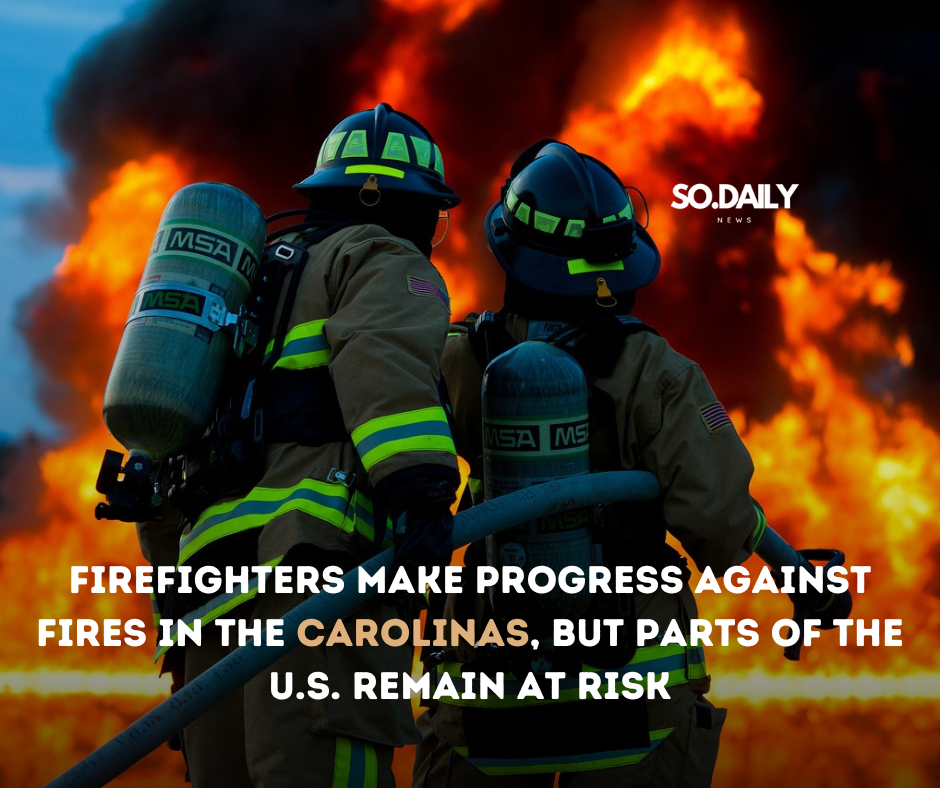Firefighters in North and South Carolina have made significant progress in combating wildfires that have threatened communities and natural resources. However, despite these efforts, large portions of the United States continue to face heightened wildfire risks due to climatic and environmental factors.
Wildfire Outbreak in the Carolinas
Over the past week, the Carolinas have experienced a surge in wildfire activity, primarily driven by dry conditions, gusty winds, and unusually high temperatures for the season. South Carolina Governor Henry McMaster declared a state of emergency as nearly 5,000 acres burned, with 170 reported fires. The most significant incident, the Carolina Forest fire in Horry County, consumed 1,200 acres and remained uncontained, prompting evacuations and the deployment of over 400 firefighters, including support from Black Hawk helicopters.
In North Carolina, the Melrose fire in the Blue Ridge Mountains affected 400-500 acres and remained uncontrolled. Firefighting strategies included aerial water drops and the use of tractors to establish containment lines. Emergency services continue to work diligently to manage these fires and protect affected communities.
Climate Change and Increasing Wildfire Risks
The frequency and intensity of wildfires in the U.S. are escalating, with climate change playing a pivotal role. Rising spring temperatures have led to earlier snowmelt, reducing summer water resources and increasing wildfire risks. Studies indicate a 2.4°F national average temperature rise over the past 55 years, correlating with more severe wildfire seasons. Notably, Los Angeles experienced over 200 fire alerts between January and February 2025, a stark contrast to historical patterns where such alerts were rare during these months.
Scientists at the Missoula Fire Sciences Laboratory in Montana express concern over wildfires encroaching on populated areas, attributing this trend to communities expanding into forested regions and exacerbated by dry, windy conditions. This urban-wildland interface poses significant challenges for fire management and community safety.
Federal and State Preparedness Initiatives
In response to the growing wildfire threat, federal agencies like the National Interagency Fire Center (NIFC) have issued seasonal outlooks highlighting areas with elevated fire potential. These forecasts assist in resource allocation and preparedness planning. For instance, the NIFC’s outlook for February through April 2025 identified regions with increased wildfire risks, prompting proactive measures.
States are also enhancing their wildfire preparedness. Virginia’s Governor, Glenn Youngkin, reminded residents that nine out of ten wildfires are caused by human activity, emphasizing the importance of responsible outdoor practices to mitigate fire risks.
Looking Ahead: A Prolonged Fire Season
The 2025 wildfire season is expected to be prolonged and more severe, with experts attributing this to a combination of climatic shifts and human activities. The U.S. Forest Service’s Community Wildfire Defense Grant Program aims to assist high-risk communities in preparing for wildfires, though challenges persist in securing adequate funding, particularly for under-resourced rural areas.
As climate change continues to influence weather patterns, leading to warmer temperatures and altered precipitation, the U.S. faces an urgent need to bolster wildfire mitigation and preparedness strategies. This includes investing in fire-resilient infrastructure, enhancing public awareness, and ensuring robust funding for research and prevention programs. Only through comprehensive and sustained efforts can communities hope to effectively address the escalating threat of wildfires in the coming years.
